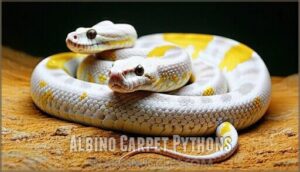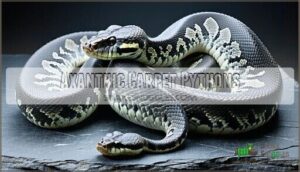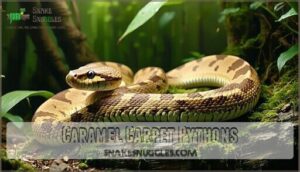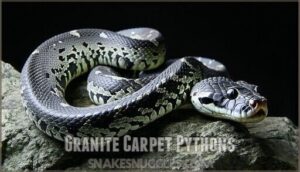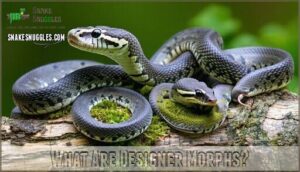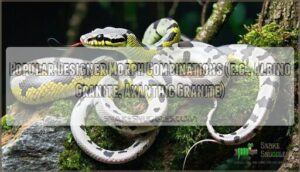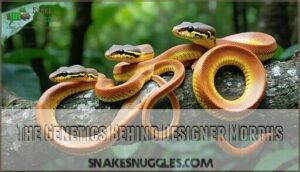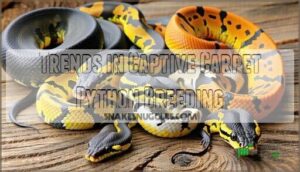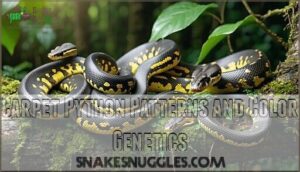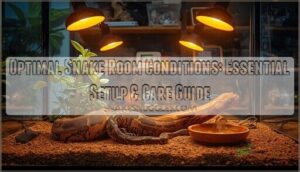This site is supported by our readers. We may earn a commission, at no cost to you, if you purchase through links.
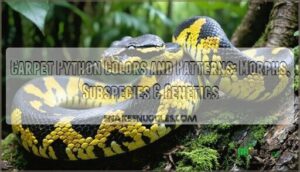
In the wild, morphs like albino and axanthic add cream, silver, or caramel tones, making every individual a walking work of art. Captive-bred designer morphs mix and remix these traits, creating new patterns faster than you can say “genetics.”
Whether you’re eyeing a classic look or a one-of-a-kind pet, this python’s palette keeps you guessing at every turn.
Table Of Contents
Key Takeaways
- Carpet python colors and patterns vary widely by subspecies, from bold yellow Jungle Carpets to black-and-white Diamond Pythons, reflecting unique adaptations to their habitats. – Natural and captive-bred morphs, including albino, axanthic, caramel, and designer combinations, result from selective breeding and genetic mutations, making each individual visually distinct. – The environment, such as temperature, humidity, and lighting, strongly influences both the appearance and well-being of carpet pythons, with specific needs depending on the morph or subspecies. – Responsible breeding and sourcing practices are crucial for maintaining healthy genetic diversity, ethical husbandry, and ensuring long-term welfare for both wild and captive populations.
Carpet Python Subspecies and Their Range
Carpet pythons span diverse regions across Australia and into New Guinea, with each subspecies shaped by its unique environment.
Understanding where these pythons live and how they’ve adapted helps you appreciate the striking variation in their colors and patterns.
Major Carpet Python Subspecies Overview
If you’ve ever wondered just how diverse carpet pythons can be, you’ll find their subspecies offer more variety than most people expect. Subspecies identification is essential, with unique traits surfacing in each lineage.
Paying close attention to subspecies, keeping an eye on hybrids, and watching their conservation status all play a huge part in shaping future research.
Together, these steps give us a real sense of just how many kinds of carpet pythons are out there.
Geographic Distribution Across Australia and New Guinea
Spread out across Australia’s wild corners and even into New Guinea, these python subspecies each carve out their own distinct patch of the map. You’ll find:
- Rainforests, deserts, and rocky outcrops reflecting true habitat variation
- Island populations adapting under unique environmental pressures
- Conservation mapping tracking Carpet Python subspecies distribution from the Top End to the farthest Australian fringe
Unique Characteristics of Each Subspecies
Take a closer look, and Carpet python subspecies really set themselves apart. The compact, vivid Jungle Carpet (Morelia spilota cheynei) contrasts sharply with the hefty, mellow Diamond Python. Scale patterns run from crisp stripes to intricate lattices, while size, color variations, and temperament differences make species identification almost an art. These snakes thrive in tropical surroundings with dense vegetation.
| Subspecies | Signature Trait |
|---|---|
| Jungle Carpet | Bright yellow, slender |
| Diamond Python | Glossy black, calm |
| Coastal Carpet | Largest, variable patterns |
| Irian Jaya/Papuan | Earthy hues, small |
| Centralian/Southwest | Reddish or olive, sturdy |
Typical Habitats and Environmental Adaptations
Dense canopies favor arboreal types, while rugged ground or suburban gardens can sustain terrestrial hunters. Habitat diversity drives Carpet Python subspecies distribution across Australia.
Some thrive where prey abounds in humid forests, while others cope with harsher climates or even urban environments. Climatic adaptations—like coloration or hunting strategies—let each Carpet Python carve its niche in the mosaic of their habitats.
Natural Carpet Python Color Morphs
Carpet pythons come in a variety of natural colors and patterns, each shaped by genetics and their wild habitats. Let’s look at the key natural morphs you might encounter.
Albino Carpet Pythons
There’s something almost otherworldly about an albino carpet python—its creams and yellows shine so brightly, you might think you’re looking at a snake painted by sunlight itself.
Albino genetics, specifically tyrosinase negative mutations, strip away dark pigment, making each Albino a standout among Carpet Python morphs.
Their visual appeal draws breeders and enthusiasts, inspiring dedicated breeding programs and fueling continued fascination with color mutations.
Axanthic Carpet Pythons
If you’ve ever wondered what a carpet python would look like without its signature golden hues, axanthic morphs are here to show you just that. Axanthic genetics block yellow pigment, leaving you with silver, charcoal, and black tones—a stark contrast to other Carpet Python color mutations. Identifying Axanthics involves spotting these cool, monochrome patterns, all tied to simple recessive mutations.
- Silvery-gray scales highlighted by black markings
- Cooler, understated patterns compared to typical Carpet Python color genetics
- Popular in breeding projects for dramatic Axanthic variations
Caramel Carpet Pythons
Warm caramel tones catch your eye right away when you spot one of these uniquely colored Carpet Pythons. Thanks to Caramel genetics, especially from strong Coastal influence, these snakes show striking color intensity—ranging from soft gold to bold amber.
Selective breeding has refined this morph, deepening hues and paving the way for future morphs in Carpet Python genetics and snake color mutations.
Granite Carpet Pythons
Imagine a Carpet Python patterned like polished stone—a Granite morph lives up to its name with a look that turns heads in any collection.
Granite genetics create a mosaic of broken speckles, making each individual unique. You’ll see Granite localities with subtle variations, a hallmark of Carpet Python morphs.
Granite breeding expands these appearance possibilities, fueling ongoing fascination with Carpet Python genetics.
Zebra Carpet Pythons
What if you could spot a python dressed in bold, black-and-gold stripes, zigzagging through the trees like living lightning? That’s the Zebra—a striking Carpet Python morph, instantly recognized for its vivid, broken bands.
Zebra genetics can be unpredictable, breeding challenges included, but the morph’s popularity keeps growing. Identifying Zebras is all about pattern variations—no two snake patterns are alike.
How Natural Morphs Occur in The Wild
Picture a python winding through a patchwork of forest and suburb: wild morph genetics shape each pattern, but chance, not certainty, rules. Unique colour variations arise in spots where subspecies’ ranges overlap or in fragmented habitats. Urban adaptation sometimes favors cryptic hides, while morph collection pressure can reshape populations. Axanthic mutations can be recessive.
- Snake mutations spark rare visual surprises
- Ecotone morph frequency drives hotspots
- Habitat fragmentation reveals subtle genetic traits
- Urban Carpet Pythons master camouflage
Designer and Captive-Bred Morphs
Designer and captive-bred morphs open up a world of color and pattern possibilities you won’t find in the wild.
Here are some of the most popular options for your own collection.
What Are Designer Morphs?
How do breeders create such striking carpet python patterns that you’d never spot in the wild? Designer morphs are the result of intentionally pairing specific Carpet Python morphs to produce new color and pattern variations. These unique outcomes blend Morph Combinations, Genetic Interactions, and careful Breeding Ethics, shaping current Morph Popularity but also the possibility of Future Morphs.
| Term | Meaning |
|---|---|
| Designer morphs | Captive-bred Carpet Python color morphs |
| Genetic Interactions | How traits combine during breeding |
Popular Designer Morph Combinations (e.g., Albino Granite, Axanthic Granite)
You’ll notice Morph market trends favor striking designer morphs like Albino Granites and Axanthic Granites. Pairing Granite’s recombination variability with other morphs has made these standouts in designer clutch genetics.
Their demand highlights ongoing interest—though vigilance with ethical breeding practices is needed due to phenotype expression anomalies occasionally observed in Carpet Pythons bred for ever more ambitious color and pattern combinations.
The Genetics Behind Designer Morphs
You’re not just seeing pretty snakes—designer morphs are about python genetics in action. The variety stems from deliberate combinations of Carpet Python Morphs, where:
- Morph Inheritance follows recessive or co-dominant paths
- Gene Combinations create unique snake color morphs
- Hybrid Vigor aids genetic health
- Line Breeding polishes features
- All subspecies crossbreed readily, powering Carpet Python Color Genetics
Trends in Captive Carpet Python Breeding
Once you understand the genetic possibilities, it’s easy to see why captive Carpet Python breeding trends keep evolving with each new season’s creative pairings and unexpected hatchlings. Breeders chase Morph Popularity while balancing Genetic Diversity and Ethical Breeding.
Demand for striking snake color morphs nudges innovators toward ever more dazzling New Combinations, fueling a lively Carpet Python breeding market.
Carpet Python Patterns and Color Genetics
Regarding carpet python patterns and colors, genetics play a huge role in what you’ll see. Here’s a look at the different pattern types and how they come about.
Common Pattern Variations (striped, Banded, Jaguar, Etc.)
It’s remarkable how the same species of carpet python can wear anything from bold stripes to swirling bands, each pattern telling a story as unique as the snake itself. You’ll spot:
- Classic striped variations snaking down the back, showing strong pattern heritability. – Banded genetics giving rise to contrasting, clean bands. – Wild jaguars, famous for unpredictable morph variations and dramatic pattern fading.
How Genetics Influence Color and Pattern
When you look closely at Carpet Python morph variations, you’re seeing the subtle dance of gene expression in action. Mutations in specific genes change pigment cell development or disrupt pattern formation, resulting in dramatic shifts in snake coloration and patterning.
Whether it’s simple Mendelian inheritance, the blending of genes through hybridization, or the appearance of brand-new color morphs, all these genetic twists and turns come together to create such a stunning range of looks.
Breeding Strategies for Specific Morphs
Whether you’re drawn to bold stripes or rare color combos, developing the right breeding strategy can reveal stunning new looks in your carpet pythons. Here’s what matters:
- Morph-specific pairings to guarantee pure morphs or targeted color morphs
- Genetic compatibility checks
- Incubation techniques for healthy offspring
- Selective breeding for desired traits
- Mutation amplification for striking results
Rare and Unique Pattern Mutations
Rarity is the thread that weaves excitement into carpet python morphs. Striped and patternless examples often emerge unpredictably, the result of spontaneous stripe propagation rather than careful planning.
High-value morphs—such as Hypo Jaguar and Axanthic Granites—are prized but demand consideration for Jaguar ethics, attention to Granite genetics, and awareness of fluctuating Hypo prices within the broader tapestry of reptile breeding.
Caring for Colorful Carpet Pythons
Choosing the right setup for your carpet python is the first step to keeping it healthy and thriving.
Here’s what you need to know about the best enclosure options for these vibrant snakes.
Habitat Setup for Morphs and Subspecies
Setting up the perfect home for your carpet python starts with one essential truth: not all morphs and subspecies thrive in the same kind of environment. Pay attention to morph-specific needs—some require more vertical space, while others benefit from dense enrichment.
Subspecies enclosure size varies, as does lighting—Jungle morphs, for example, favor brighter habitats. Always consider natural, seasonal variations for best carpet python care and habitat.
Temperature and Humidity Requirements
Think of temperature and humidity as the invisible hands shaping your carpet python’s comfort and long-term health. Offer a basking spot nearing 36°C and let night drops mimic seasonal variation, promoting natural rhythms.
Build a humidity gradient across the enclosure—raise humidity for shedding, dial it back for daily life. Mimic wild carpet python habitats for resilient, thriving snakes.
Importance of UVB and Environmental Enrichment
After you’ve dialed in temperature and humidity, adding the right UVB lighting and giving your python places to climb or explore can make daily life more interesting—and a lot healthier.
UVB benefits are clear: stronger bones and better behavior. Aim for the proper Ferguson zones, offer both branches and ledges, and you’ll spot natural behaviors that mark truly healthier pythons.
Conservation and Responsible Breeding Practices
A thriving Carpet Python population isn’t just about pretty patterns—it’s about sustaining genetic diversity and healthy bloodlines. That means respecting breeding regulations, monitoring populations closely, and choosing ethical sources. Here’s what matters most:
- Track lineage—avoid inbred hybrids.
- Champion habitat preservation.
- Choose captive breeding over wild capture.
- Favor pure wild type and codominant morphs.
- Prioritize ethical breeders.
Availability and Ethical Considerations for Pet Owners
Choosing Carpet Pythons for your collection brings up real questions: Where do they come from, captive breeding or wild-caught? Ethical sourcing matters—about 85% in today’s pet trade are captive-bred, but hybrid concerns and breeder regulation still shape the landscape.
| Sourcing Ethics | Owner Commitment |
|---|---|
| Captive vs. Wild | Long-term care |
| Hybrid Concerns | Space needs |
| Breeder Regulation | Continued welfare |
Before you commit, weigh the realities: long-term care, space needs, and continued welfare are essential considerations.
Frequently Asked Questions (FAQs)
Can carpet python colors change as they age?
Have you noticed how some juvenile snakes seem to transform before your eyes? Carpet Pythons may shift from bright hatchlings to darker specimens with age, influenced by shedding, diet, genetic expression shifts, and other subtle color change triggers.
Are certain morphs more prone to health issues?
Some Carpet Python morphs, especially Albinos and Jaguars, can face genetic predispositions to health issues.
Morph health risks may include neurological symptoms or reduced lifespan.
Responsible breeding choices and ethical considerations help minimize breeding consequences and foster strong genetics.
Which carpet python colors are most in demand?
The boldest demand in Carpet Pythons centers on Albinos, Jaguars, and rare Axanthics, with Morph Popularity and Price Drivers closely tied to Rarity Influence.
Breeder Focus often shifts with Future Trends, especially as new Caramels emerge.
How do lighting conditions affect python coloration?
Ever noticed how a python’s dark colouring seems to shift with the seasons?
The light spectrum—especially UVB—can influence melanin production, benefit Albinos or Axanthics, and even bring out unique snake markings through subtle temperature correlation.
Are color mutations linked to temperament or behavior?
It’s natural to wonder if certain morphs in Carpet Pythons act differently, but the truth is, changes in color or pattern—including hybrids or wild markings—don’t really affect their personalities.
If anything, behavior is more about genetics and selective breeding, and even then, the differences tend to be minor.
Conclusion
Much like a living tapestry, carpet python colors and patterns weave together evolution, environment, and genetics into a striking display. From wild morphs to designer combinations, each subspecies offers a glimpse into nature’s endless creativity.
Understanding the palette of these snakes—whether classic or unique—allows you to make informed choices and appreciate their ecological importance. Your fascination with carpet python colors and patterns ultimately aids responsible care, conservation, and a deeper bond with these reptiles.

